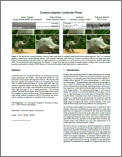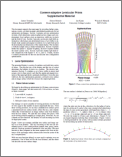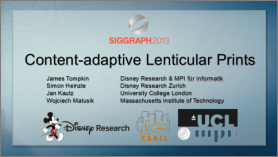SIGGRAPH 2013 |
||
Content-adaptive Lenticular Prints |
| James Tompkin | Simon Heinzle | Jan Kautz | Wojciech Matusik |
| Disney Research/MPI für Informatik | Disney Research Zurich | University College London | Massachusetts Institute of Technology |
 |
| Abstract | |
Lenticular prints are a popular medium for producing automultiscopic glasses-free 3D images. The light field emitted by such prints has a fixed spatial and angular resolution. We increase both perceived angular and spatial resolution by modifying the lenslet array to better match the content of a given light field. Our optimization algorithm analyzes the input light field and computes an optimal lenslet size, shape, and arrangement that best matches the input light field given a set of output parameters. The resulting emitted light field shows higher detail and smoother motion parallax compared to fixed-size lens arrays. We demonstrate our technique using rendered simulations and by 3D printing lens arrays, and we validate our approach in simulation with a user study.
|
@inproceedings{Tompkin:2013:SIGGRAPH,
|
|
|
Supplemental Video MP4 (230 MB) |
| Resources - Light Fields | ||
| Resources - Geometry | ||
|
||
|
| Resources - Code | ||
|
||
|
| © ACM, 2013. This is the author's version of the work. It is posted here by permission of ACM for your personal use. Not for redistribution. The definitive version was published in ACM Transactions on Graphics, Vol. 32, Issue 4, July 2013, http://doi.acm.org/10.1145/2461912.2462011/.
|


